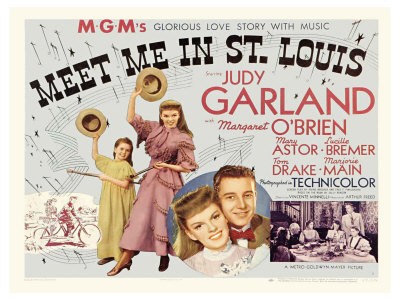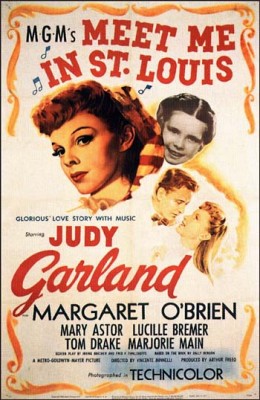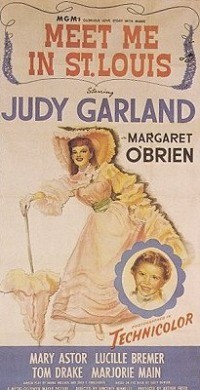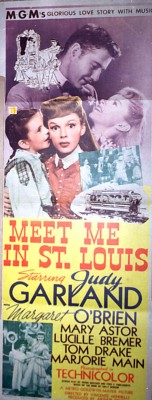| Reviews & Columns |
|
Reviews DVD TV on DVD Blu-ray 4K UHD International DVDs In Theaters Reviews by Studio Video Games Features Collector Series DVDs Easter Egg Database Interviews DVD Talk Radio Feature Articles Columns Anime Talk DVD Savant Horror DVDs The M.O.D. Squad Art House HD Talk Silent DVD
|
DVD Talk Forum |
|
|
| Resources |
|
DVD Price Search Customer Service #'s RCE Info Links |
|
Columns
|
|
|
Meet Me in St. Louis

"You could say Meet Me in St. Louis was terribly sentimental, but it actually tapped into something primal, almost like a fairy tale. Everything is perfect there, and we all desperately want the perfect family, the perfect house. And it doesn't seem arch or false because it's done with such sincerity and passion." - Terence Davies (director, Of Time and the City and The House of Mirth)
More often than I would like, I find myself pigeonholed and put on the defensive as a frowny type who only likes "depressing" movies and hates, as a matter of principle, to see anybody happy or triumphant onscreen. Not only is that a gross oversimplification of those "depressing" films (if you can watch sublimities like Cries and Whispers, Satantango, or Au Hasard Balthazar and actually get depressed, you haven't really been watching very closely, in my opinion); it's also reductive toward the great cinematic expressions of sheer, simple joy that I also cherish. I've just had the pleasure of revisiting such a work, Vincent Minnelli's giddy and jubilant (and then unexpectedly tender and near-heartbreaking) 1944 musical, Meet Me in St. Louis, an unadulterated happy experience that, in its sweet perfection, reinforces my feeling that those who would pit it against, say, Lars von Trier's purportedly "anti"-musical Dancer in the Dark, with the apparent presumption that such fully manifest anguish and such ecstatic delight somehow cancel each other out, don't truly understand or appreciate either, or the fact that they occupy two points on a shared musical continuum of powerful, unabashed emotion.
The story of Meet Me in St. Louis, based on Sally Benson's series of homey New Yorker sketches about the life of a middle-class St. Louis family right after the turn of the last century, is as deceptively light, straightforward, and female/domestic life-centered as a Jane Austen novel, with its four Smith sisters--twentysomething Rose (Lucille Bremer), late-teen Esther (Judy Garland), prepubescent Agnes (Joan Carroll), and seven-year-old "Tootie" (Margaret O'Brien)--and one fairly peripheral brother, Alonzo (Henry H. Daniels, Jr.), and their concerns about love, marriage, and domestic stability. That stability is threatened, providing the film's principal dramatic conflict, when the imperious but ultimately befuddled and softhearted family patriarch, Mr. Smith (Leon Ames), a lawyer, accepts a job in New York. (The movie begins in autumn, 1903, with the family due to leave for New York at the beginning of the new year and the bulk of the action taking place in the meantime.) Mr. Smith's unilateral decision is distressing news: Rose, in danger of becoming a spinster and already convinced she's been dumped by her college-attending boyfriend who is himself spending most of his time in New York, has prospects in St. Louis; Esther is fast on her way to falling in love with John Truett (Tom Drake), literally the boy next door; and their beloved, spacious, homey and lived-in Victorian-style house will be replaced by some undoubtedly crowded and impersonal New York flat. But the girls, their mother (Mary Astor, The Palm Beach Story), their grandfather (Harry Davenport), and their benignly crusty housekeeper, Katie (Marjorie Main, best known from the Ma and Pa Kettle films)--the latter two live-in members of the family, significantly making the Smiths something closer and more extensive than a nuclear unit--resign themselves to Mr. Smith's decision and attempt, heavy-hearted but with pragmatic energy, to make the most of their last Halloween and Christmas in St. Louis (setting the stage for the film's important Halloween and Christmas-dance sequences) and the fact that they will miss out on the deliriously anticipated World's Fair set to be held in their city in 1904. The only thing that might reverse the Smiths' sad fate is event somehow conspiring to show Mr. Smith how vital home and hometown are to his brood, cracking the shell of cold worldly ambition he's grown over his true, kind nature.

It's a simple story that could easily have coasted on corny sentimentality, but Minnelli and company--including, in addition to the perfectly complementary cast, composers Ralph Blane and Hugh Martin and cinematographer George Folsey--imbue it with startling charm, magic, and insouciance, transforming it into something like a thrilling trolley ride through a storybook world. If there's something tiresomely leaden and cynical about much of contemporary mainstream escapist cinema, with its hyper-contrived, desperately "impressive" special-effects whimsy (I'm looking in your direction, George Lucas) and depressingly meticulous demographic targeting and sitcom-family character conceptions, Meet Me in St. Louis is a glorious reminder that the dream factory once was capable of manufacturing the lightest, most delicate baubles: it may stand as the best example of the colorful, fantastical, idealized world evoked whenever someone says "MGM musical." Every frame gives off the aura of having been lovingly made, whether in the way it is designed, shot, performed, choreographed, or sung; Minnelli's very use of color, light, and shadow (most memorably in the surprisingly dark, melancholy scene near the end of the film, in which Garland croons "Have Yourself A Merry Little Christmas" to O'Brien) creates reservoirs of suggestive emotion that require more than just one viewing to fully tap.

And then there's the music. Even if you've never seen Meet Me in St. Louis, you've undoubtedly heard at least some of Hugh Martin and Ralph Blane's songs for the film, if only "Have Yourself A Merry Little Christmas" during the holiday season, or Nora Dunn and Jan Hooks's "Sweeney Sisters" rendition of "Clang, Clang, Clang (The Trolley Song)" on SNL in the '80s. They've become a part of the American songbook, and though they're unfailingly perky and ebullient, they never cross that line into the sickly sweet, thanks in part to their fairly seamless integration into the story. The film was one of the first Hollywood studio musicals to do an 180-degree turn away from the Busby Berkeley-style picture in which one stopped everything in order to display, jewel-like, the film's discrete, impossibly elaborate song-and-dance numbers, which would be the most easily remembered bits and would outshine by far what came to seem, in context, the purely incidental or disposable stories. All the singing and dancing in Meet Me in St. Louis is presented naturalistically, as part of the characters' lives and the world they inhabit, and the film attains a near-perfect balance between "book" and "music" that paved the way for a masterful series of Hollywood musicals--including Stanley Donen and Gene Kelly's Singin' in the Rain and Minnelli's own An American in Paris--done in a similarly holistic vein.
Minnelli is one of those directors--his most readily identifiable peer being George Cukor (Gaslight, A Star is Born)--who mastered dramatic and musical forms equally, and his work has been venerated by everyone from Martin Scorsese (who featured Meet Me in St. Louis prominently in his Personal Journey Through American Cinema) to critic Glen Kenny (whose "Some Came Running" website is named after one of Minnelli's non-musical films). One doesn't need to know anything about all that to get a spring in one's step from exposure to the truly magical Meet Me in St. Louis, or to be swept away by its exhilaratingly sustained artifice. But the pleasure of re-experiencing it does also serve as a jolting reminder of Minnelli's comparative neglect, film-canonically speaking, and as a great example of why he deserves (despite never having made a Western, apparently the deal-breaker for great-American-cinéaste status in his era) to be as widely known and celebrated as your John Fords and Howard Hawkses.

THE BLU-RAY DISC:
Every last bit of George Folsey's Technicolor richness is present and accounted for throughout this AVC/MPEG-4, 1080/24p, 1.37:1 aspect ratio transfer. There is nary a compression artifact to be seen, and a pleasing celluloid texture has been retained; the disc well succeeds at providing the conscientiously cared-for visual experience the film deserves. The very occasional, millisecond-long hyper-saturation/color flicker is an endemic degradation of the Technicolor process and does not significantly detract from the film's overall very fine presentation here. (Given the film's age and the fragility of such earlier-on Technicolor materials, it's frankly miraculous that it looks as near-perfect as it does.)
Sound:The DTS-HD 5.0 Master Audio soundtrack is sparkling, with all of the film's dialogue--and, especially, music--clear, rich, and full. No distortions or tinniness are present that wouldn't be accounted for by the sound-recording technology of the era; in fact, in light of that qualification, Meet Me in St. Louis actually seems to be a rather advanced example of what could be done with sound at the time, a quality that is very well preserved here.
Extras:Most of the extras have been carried over from the prior deluxe DVD edition, and it is a veritable cornucopia of supplements, including:
--A five-minute introduction by Liza Minnelli, in which the famous (notorious?) daughter of director Minnelli and star Garland gives a light, warmly personal appreciation of the film and a romantic reminiscence on how her parents came to be involved in the project together. (Garland, who longed to grow up, had to be convinced and cajoled into playing a teen yet again.)
--"Meet Me in St. Louis: The Making of an American Classic," a 30-minute special made in 1994 for Turner Classic Movies. Narrated by Roddy MacDowell and including new interviews with Margaret O'Brien (who, as a child, played "Tootie") and co-composer Hugh Martin alongside archival interviews with Vincent Minnelli and footage of Garland performing beloved numbers from the film later in her career, as well as glimpses of the lavish marquee and outdoor advertising campaign the film received during its run. This piece is an excellent, fairly detailed introduction to how Meet Me in St. Louis came to be and what it came to mean.
--A feature-length commentary that is a tapestry of voices, with Garland biographer John Fricke as the organizer, introducer, and ringleader of a chorus that includes separately recorded interviews with actress Margaret O'Brien; producer Arthur Freed's widow, Barbara Freed-Saltzman; co-composer Hugh Martin; and screenwriter Irving Brecher. Fricke is the one who addresses what's actually onscreen, and one feels a commentary with him alone would have sufficed; however, the others' comments are relevant in their own way, too, and redeem the overall slightly jumbled and digressive feel of the commentary.
--Hollywood: The Dream Factory, a 50-minute documentary produced for TV in the nostalgic 1970s by the then-faded MGM and narrated by Dick Cavett, relating the history of Hollywood from its inception to the studio system's demise, all centered around MGM and Louis Mayer (this piece's one very loose connection to Meet Me in St. Louis itself). Packed with interesting facts and clip after clip from Hollywood's heyday (seen through both great old films and offscreen newsreels/documentation), this is a fascinating, informative treat for any movie lover.
--Becoming Attractions: Judy Garland, an installment of the Turner Classic Movies series dedicated to compiling movie trailers, this one recapping all the previews spanning Garland's film career. TCM's principal avatar, Robert Osborne, introduces and contextualizes each group of previews (shown mostly in their full, uncut length). This is another of the disc's several treasure troves of Tinseltown history.
--The "Meet Me in St. Louis" (1966) television pilot, a total curiosity and creepy reminder of the darker side of the dream factory. Only a blind drive for squeezing profit from a past glory could have allowed this travesty of the film, remade as a stale TV sitcom, to have come to pass; the final insult is that there is a freaking laugh track. The pilot is an absolutely a relevant inclusion, but let me know if you can take more than five minutes of it, in which case you deserve some kind of award commemorating your stomach and stamina.
--Two shorts that preceded and anticipated the feature: Bubbles, a mini musical revue from the very beginning of the sound era, in which you can see a little Judy Garland performing, as part of the vaudeville act The Gumm Sisters, in a number called "The Land of Let's Pretend"; and Skip to My Lou, a 1940 version of the song featured in the film, sung and danced by the film's composers-to-be, Hugh Martin and Ralph Blane, as part of a troupe called The Martins.
--An "audio vault" featuring a music-only soundtrack option for running the film, a song taken out of the film called "Boys and Girls Like Me and You," and an hour-long Lux Radio Theater rendition of the film featuring the voices of Garland, O'Brien, and other cast members.
--This release is a "Blu-ray book" edition that includes, between its hard covers, a 40-page inner booklet that, while very short on anything resembling critical analysis, is long on actor/director mini-bios and filmographies, trivia tidbits, song lyrics, and, most extensively, beautiful promotional photos and stills from the film. Considered exclusively as a souvenir/scrapbook rather than a Criterion-level education on the film, it's a pretty neat little bonus.
--Finally, a theatrical trailer from one of the film's early re-releases, and a four-song CD sampler that collects a small handful of the film's most popular songs for your listening pleasure. (Given that this disc is getting a December release, the inclusion of "Have Yourself a Merry Little Christmas"--a song first heard in the film before it become a stand-alone Christmas classic--won't go amiss.)
FINAL THOUGHTS:Vincent Minnelli's early masterpiece has always been a wonderful-looking and -sounding picture, but it has never looked or sounded as wonderful as it does on this beautifully done new Blu-ray release. Going beyond the deluxe Blu-ray presentation to consider it solely on its cinematic merits, Meet Me in St. Louis is innocent and sweet without becoming naive or saccharine; it's old-fashioned in the best possible way, classical Hollywood studio filmmaking in top form. Despite being set in 1903 and released in 1944, its genuinely, sincerely gratifying energy is as timeless as it is contagious, and even the most resolutely down-to-earth and pro-realist movie buff will have a very difficult time resisting the unfettered ingenuity, skill, and passion with which it was made. Highly Recommended.
|
| Popular Reviews |
| Sponsored Links |
|
|
| Sponsored Links |
|
|
| Release List | Reviews | Shop | Newsletter | Forum | DVD Giveaways | Blu-Ray | Advertise |
|
Copyright 2024 DVDTalk.com All Rights Reserved. Legal Info, Privacy Policy, Terms of Use,
Manage Preferences,
Your Privacy Choices | |||||||











